Developer: Blackbird Interactive
Publisher: Gearbox Software
Review Platform: PC (Steam)
Release Date: January 20, 2016
Cards on the sand-covered table: I’m almost completely new to the Homeworld series. In spite of my Homeworld virginity and my occasional dunder-headedness when it comes to established RTS series, Blackbird Interactive’s revival of the series proved surprisingly easy to swallow. By taking the series out of the vacuum of space, and rooting it on the desert planet of Kharak, Blackbird has created something akin to a tense, arid road movie, albeit with armoured laser tanks and religious space-nuts instead of soft-top cars and Sean William Scott.
Serving as a prequel the 1999 original, Deserts of Kharak puts you in the dusty boots of the Kushan people, as they attempt a last-gasp pilgrimage to find the ‘Jaraci Object’, an artifact allegedly containing the power to end their war against the Gaalsien people. It’s all fairly standard as sci-fi stories go – there’s a war, there’s a macguffin, and a bunch of weird foreign zealots vying for your planet – but it’s easy to understand, even without prior series knowledge. As with most RTS games, the focal point of Deserts is its systems, rather than its narrative trappings.
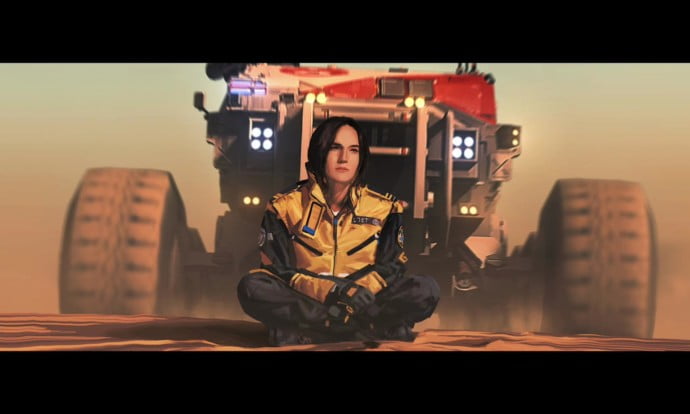
Rather than having you set up a base of operations from which your vehicles sally forth, Deserts is all about perpetual motion. Your base is the Kapisi, a mobile, hulking, landlocked aircraft carrier that produces salvage vehicles, support cruisers, aircraft, as well as standard combat vehicles. Ground units effectively play by a “Rock, Paper, Scissors” set of rules: light units are fast and can overrun slower, ranged railguns, heavy assault tanks operate at medium range and can take out light units easily, but are vulnerable to railguns. Aircraft are pretty much unbeatable, but are only good for one bombing run every few minutes; more like an ancillary ‘power’ than a reliable unit. This set of rules is strong, both in theory and execution – the game’s variety then comes through its ability to implement this toy box in different ways.
Blackbird’s history with the Company of Heroes series is pretty evident from the get go. Missions in Kharak play out like CoH‘s ‘Airborne’ missions, wherein you receive limited resources, and are forced to make strategic decisions in order to keep your mobile base operational. You can still create new units, but you’re basically making do with what you’ve got – you are, after all, on a desert pilgrimage. My earlier comparison to a road movie wasn’t merely made in jest – resources and troops carry over from one campaign mission to another, so there’s always an ever present sense that poor performance in one theatre could adversely affect survivability in the next. This creates a lingering sense of dread akin to The Banner Saga, which is entirely befitting of Kharak’s lifeless desert landscapes.
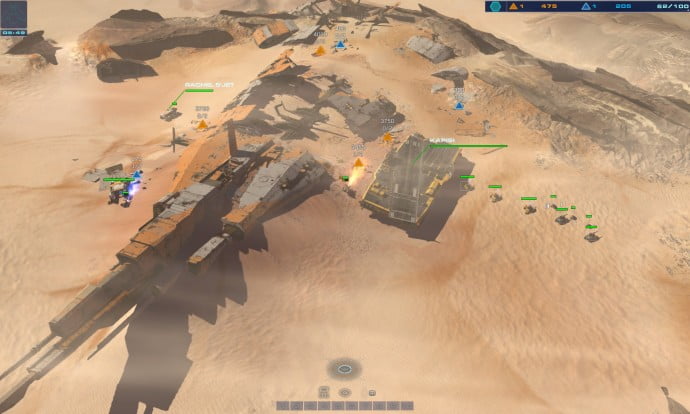
Since you’re approaching each mission blind, it pays to be careful. Though long range sensors can pick up enemy unit movements, they can’t actually determine what types of units are approaching, or how many there are. In light of this, it makes sense to bide your time, attempt bombing runs and mortar hits from behind large sand dunes, and carefully swipe resources from under your opponent’s gas masked noses. It’s an oddly tranquil experience, a calm of guerilla hits before the inevitable sandstorm of an all out assault on enemy placements.
Though it’s a satisfying gameplay loop, it does create problems. Since a great deal of your initial mission time is spent gathering resources and waiting for abilities to recharge, it’d be handy if there was a fast-forward button. It’s a consistent gripe I have with a lot of RTS games, but unless you’re XCOM, there’s inevitably going to be some downtime, downtime that could be easily avoided with time manipulation tools. I appreciate Kharak taking its foot of the pedal every now and then, but watching salvage units carting about between resources gets a bit dull after a while.
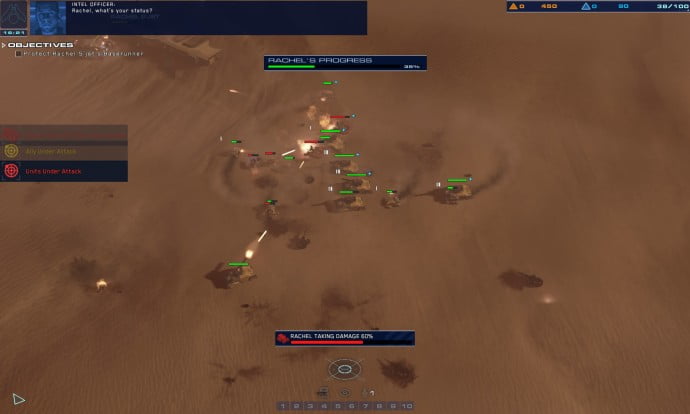
When the sand does hit the fan, however, it’s a tense experience, requiring careful unit placement, clever utilization of abilities, and the wherewithal to keep track of background resource management. Kharak is a surprisingly lively planet, despite being mostly, y’know, beige. Gaalsien structures are immense, black domes – like if Ridley Scott designed the Taj Mahal – and there’s a real heft to the way units move across the battlefield. Tanks and cruiser don’t just glide limply across the dunes, they clatter across its surfaces with a tangible sense of weight. This is especially true of light assault vehicles, which all seem to be piloted by stuntmen from Mad Max: Fury Road, they bound about with such reckless abandon.
It’s also great to be able to hear ambient comm chatter sputtering between vehicles. Idle talk of weapon malfunctions and engineering difficulties makes your convoy feel like a real, believable group of humans, despite the fact that you never see a single human figure dismount on the battlefield. The occasional: “Picking up enemy signals on long range scanners. Confirm?” is a delightful way of increasing player paranoia, especially since it often turns out to be a red herring.
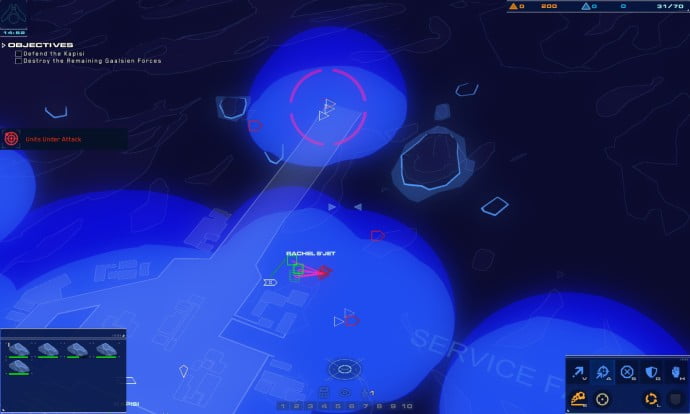
Deserts of Kharak is extremely playable. It’s easy to grasp, surprisingly simple to master, and drip feeds new features and mission types over the course of its campaign, not content to blow its load early like a lot of games might. A smooth, gradual difficulty curve only accentuates this – the harder the missions get, the more toys your convoy gets to play with, so that no mission ever feels unfair or frustrating.
As a narrative, Kharak is about as dry as its eponymous planet. It does what it needs to do to set up its gruelling chase/expedition, but it never succeeds in creating a sense of empathy. Chief science officer Rachel S’Jet is a conduit for players, but that’s about all she ever can be. The same can be said for the rest of the Kapisi’s crew, most of whom are simply called ‘Intel Officer’ or ‘Captain’ – names befitting of their noticeable lack of character. Unskippable cutscenes don’t help, as gorgeous as they are in their fluid, painted glory, and though the voice acting on display is as straight laced and rigid as one would expect, it doesn’t match what’s going on planetside. Sure, characters act calm during the game’s quieter sections, but their demeanour barely changes when being blown up by a volley of laser fire. It’s a shame, because Kharak is a really interesting place to be. With an art style that lands somewhere between The Martian and Mass Effect, everything is beautifully rendered to look chunky, dirty, and a little bit wonky. Everything looks as if it was built by humans, there just aren’t any humans in sight.
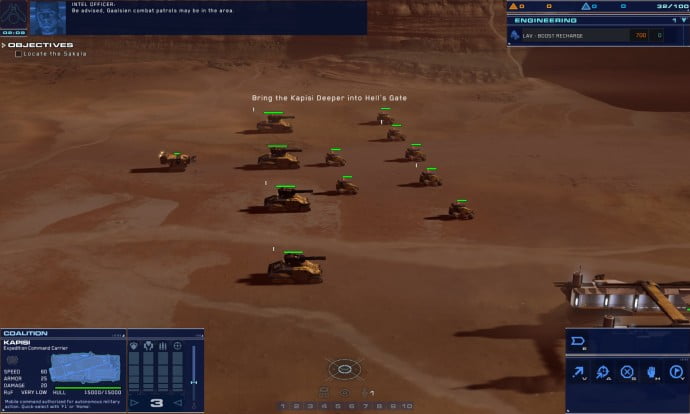
Homeworld’s multiplayer is considerably weaker than its campaign. When facing AI troops, the pace of the game is perfectly tailored and fine tuned for each mission. The same cannot be said for real humans, (blast them!) who are more than likely to engage in fairly instant air raids on your position. On the surface, the game’s online component is the same as its solo counterpart: you must deploy units to secure artifacts, and carry them to extraction points. Unlike the campaign, however, you’re given the option to spend resources on any and all abilities and units from the get go, rather than unlocking them gradually. Starting out with so many options but so little time makes these games feel uncharacteristically frantic, and frankly messy, as both teams hustle to predict which units their opponent will send out, in order to counter them.
Still, this doesn’t detract from the game’s robust campaign – Deserts holds up as a single player strategy game in its own right. The joy of Kharak ultimately comes from its leisurely pace. It’s so refreshing to play an RTS that doesn’t revel in constant, full throttle destruction – a game that knows when it’s time to let the player breathe, without sacrificing intensity. If Blackbird can hook a newbie like me, the future looks bright (or beige) for one of gaming’s most beloved series.
Review Overview
Score:
4/5
Deserts of Kharak understands that strategy games can be both beautiful and relaxing, making its brief bursts of action all the more exciting when they finally surface. A methodical, well-designed RTS that makes up for its lack of narrative oomph with simple but effective visual and audio touches.